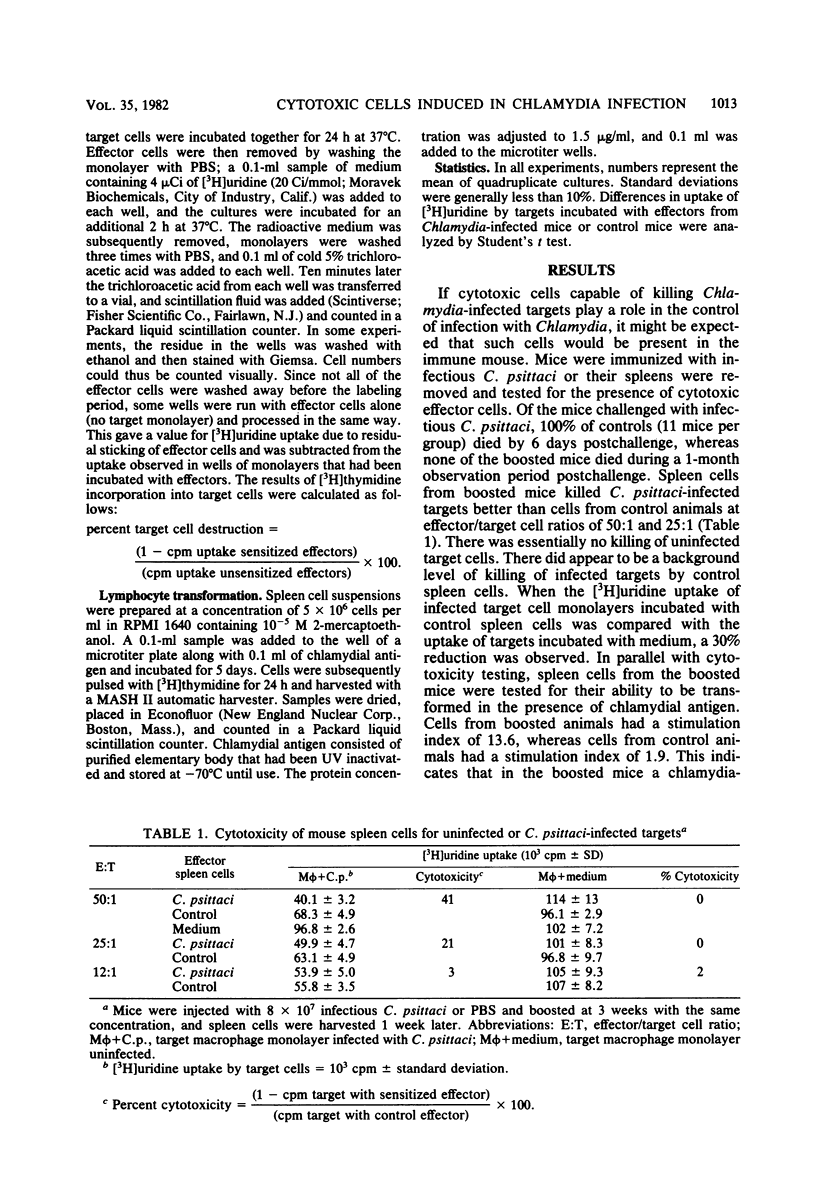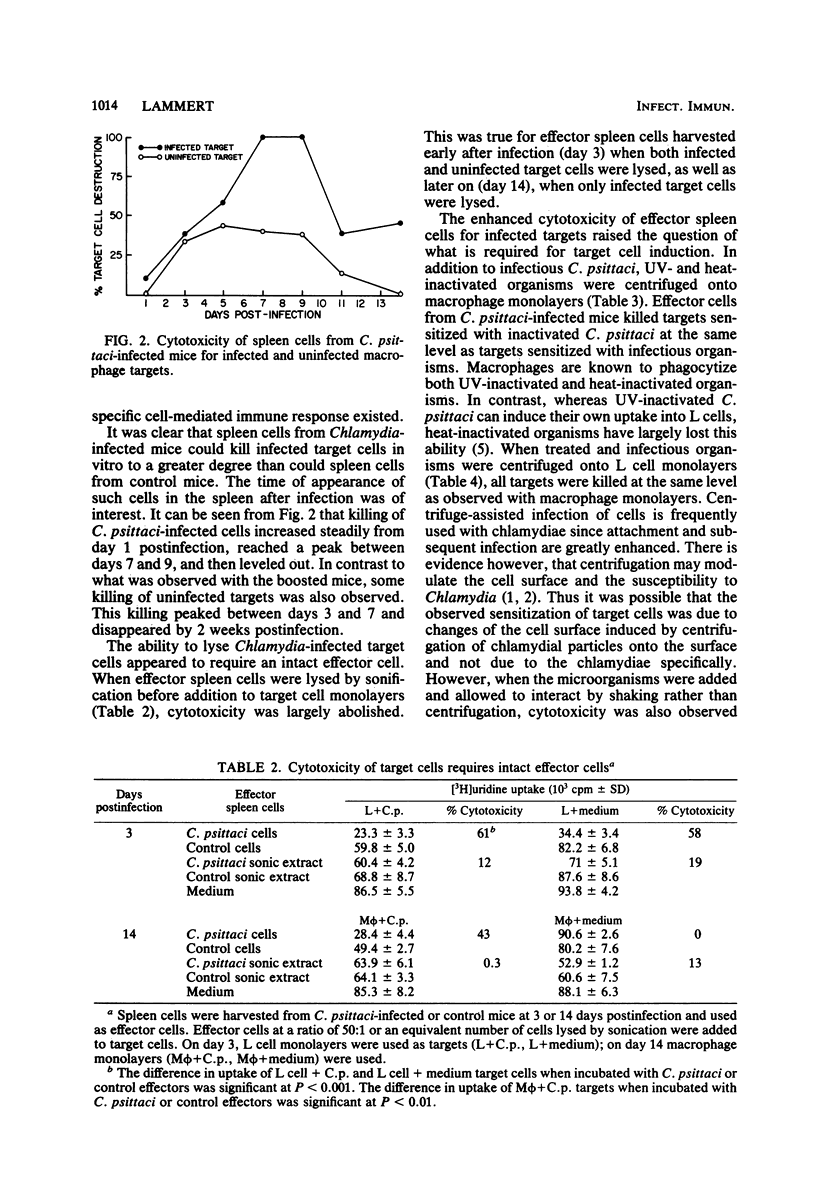Abstract
The ability of spleen cells from Chlamydia psittaci-infected mice to lyse C. psittaci-infected and uninfected target cell monolayers was studied. The cytotoxicity assay used was a terminal label method in which the number of adherent target cells surviving the interaction with effector cells was determined by measuring the uptake of [3H]uridine by such cells. It was observed that in the first few days postinfection (3 to 5), spleens contained cells that lysed infected and uninfected targets with equal efficiency. Subsequently, infected targets were killed primarily. The activity of effector spleen cells for infected targets continued, although at a reduced level, beyond 21 days postinfection. Intact effector cells were required since a disruption by sonication resulted in a loss of cytotoxicity. The enhanced killing observed with infected targets was also observed when target cells were sensitized with heat- or UV-inactivated C. psittaci. This study suggests that the induction of cytotoxic cells after C. psittaci infection may contribute to the ability of the host to control multiplication of the microorganism.
Full text
PDF






Selected References
These references are in PubMed. This may not be the complete list of references from this article.
- Ainsworth S., Allan I., Pearce J. H. Differential neutralization of spontaneous and centrifuge-assisted chlamydial infectivity. J Gen Microbiol. 1979 Sep;114(1):61–67. doi: 10.1099/00221287-114-1-61. [DOI] [PubMed] [Google Scholar]
- Allan I., Pearce J. H. Modulation by centrifugation of cell susceptibility to chlamydial infection. J Gen Microbiol. 1979 Mar;111(1):87–92. doi: 10.1099/00221287-111-1-87. [DOI] [PubMed] [Google Scholar]
- Arnstein P. Observations on chemotherapy and immunization of birds against psittacosis. Am J Ophthalmol. 1967 May;63(5 Suppl):1260–1263. doi: 10.1016/0002-9394(67)94107-4. [DOI] [PubMed] [Google Scholar]
- Byrne G. I., Moulder J. W. Parasite-specified phagocytosis of Chlamydia psittaci and Chlamydia trachomatis by L and HeLa cells. Infect Immun. 1978 Feb;19(2):598–606. doi: 10.1128/iai.19.2.598-606.1978. [DOI] [PMC free article] [PubMed] [Google Scholar]
- COHN Z. A., BENSON B. THE DIFFERENTIATION OF MONONUCLEAR PHAGOCYTES. MORPHOLOGY, CYTOCHEMISTRY, AND BIOCHEMISTRY. J Exp Med. 1965 Jan 1;121:153–170. doi: 10.1084/jem.121.1.153. [DOI] [PMC free article] [PubMed] [Google Scholar]
- Cole B. C., Aldridge K. E., Sullivan G. J., Ward J. R. Mycoplasma-dependent activation of normal mouse lymphocytes: requirement for functional T lymphocytes in the cytotoxicity reaction mediated by Mycoplasma arthritidis. Infect Immun. 1980 Oct;30(1):90–98. doi: 10.1128/iai.30.1.90-98.1980. [DOI] [PMC free article] [PubMed] [Google Scholar]
- Collier L. H., Blyth W. A. Immunogenicity of experimental trachoma vaccines in baboons. I. Experimental methods, and preliminary tests with vaccines prepared in chick embryos and in HeLa cells. J Hyg (Lond) 1966 Dec;64(4):513–528. doi: 10.1017/s0022172400040821. [DOI] [PMC free article] [PubMed] [Google Scholar]
- Hanna L., Schmidt L., Sharp M., Stites D. P., Jawetz E. Human cell-mediated immune responses to chlamydial antigens. Infect Immun. 1979 Feb;23(2):412–417. doi: 10.1128/iai.23.2.412-417.1979. [DOI] [PMC free article] [PubMed] [Google Scholar]
- Hibbs J. B., Jr, Taintor R. R., Chapman H. A., Jr, Weinberg J. B. Macrophage tumor killing: influence of the local environment. Science. 1977 Jul 15;197(4300):279–282. doi: 10.1126/science.327547. [DOI] [PubMed] [Google Scholar]
- Kazar J., Gillmore J. D., Gordon F. B. Effect of Interferon and Interferon Inducers on Infections with a Nonviral Intracellular Microorganism, Chlamydia trachomatis. Infect Immun. 1971 Jun;3(6):825–832. doi: 10.1128/iai.3.6.825-832.1971. [DOI] [PMC free article] [PubMed] [Google Scholar]
- Mackaness G. B. Resistance to intracellular infection. J Infect Dis. 1971 Apr;123(4):439–445. doi: 10.1093/infdis/123.4.439. [DOI] [PubMed] [Google Scholar]
- Merigan T. C., Hanna L. Characteristics of interferon induced in vitro and in vivo by a TRIC agent. Proc Soc Exp Biol Med. 1966 Jun;122(2):421–424. doi: 10.3181/00379727-122-31151. [DOI] [PubMed] [Google Scholar]
- Oh J. O., Ostler H. B., Schachter J. Protective effect of a synthetic polynucleotide complex (poly I: C) on ocular lesions produced by trachoma agent in rabbits. Infect Immun. 1970 Jun;1(6):566–573. doi: 10.1128/iai.1.6.566-573.1970. [DOI] [PMC free article] [PubMed] [Google Scholar]
- Ojo E., Haller O., Kimura A., Wigzell H. An analysis of conditions allowing Corynebacterium parvum to cause either augmentation or inhibition of natural killer cell activity against tumor cells in mice. Int J Cancer. 1978 Apr 15;21(4):444–452. doi: 10.1002/ijc.2910210408. [DOI] [PubMed] [Google Scholar]
- Orenstein N. S., Mull J. D., Thompson S. E., 3rd Immunity to chlamydial infections of the eye. V. Passive transfer of antitrachoma antibodies to owl monkeys. Infect Immun. 1973 Apr;7(4):600–603. doi: 10.1128/iai.7.4.600-603.1973. [DOI] [PMC free article] [PubMed] [Google Scholar]
- Page L. A. Stimulation of cell-mediated immunity of chlamydiosis in turkeys by inoculation of chlamydial bacterin. Am J Vet Res. 1978 Mar;39(3):473–480. [PubMed] [Google Scholar]
- Pfizenmaier K., Trostmann H., Röllinghoff M., Wagner H. Cell-mediated immunity in lumphocytic choriomeningitis. I. The specificity of the cytotoxic T lymphocytes. Z Immunitatsforsch Exp Klin Immunol. 1976 Apr;151(3):224–236. [PubMed] [Google Scholar]
- Piontek G. E., Weltzin R., Tompkins W. A. Enhanced cytotoxicity of mouse natural killer cells for vaccinia and herpes virus-infected targets. J Reticuloendothel Soc. 1980 Feb;27(2):175–188. [PubMed] [Google Scholar]
- REEVE P., TAVERNE J. Some properties of the complement-fixing antigens of the agents of trachoma and inclusion blennorrhoea and the relationship of the antigens to the developmental cycle. J Gen Microbiol. 1962 Mar;27:501–508. doi: 10.1099/00221287-27-3-501. [DOI] [PubMed] [Google Scholar]
- Sacks D. L., Todd W. J., Macdonald A. B. Cell-mediated immune responses in owl monkeys (Aotus trivirgatus) with trachoma to soluble antigens of Chlamydia trachomatis. Clin Exp Immunol. 1978 Jul;33(1):57–64. [PMC free article] [PubMed] [Google Scholar]
- Senyk G., Kerlan R., Stites D. P., Schanzlin D. J., Ostler H. B., Hanna L., Keshishyan H., Jawetz E. Cell-mediated and humoral immune responses to chlamydial antigens in guinea pigs infected ocularly with the agent of guinea pig inclusion conjunctivitis. Infect Immun. 1981 Apr;32(1):304–310. doi: 10.1128/iai.32.1.304-310.1981. [DOI] [PMC free article] [PubMed] [Google Scholar]
- TAMURA A., HIGASHI N. PURIFICATION AND CHEMICAL COMPOSITION OF MENINGOPNEUMONITIS VIRUS. Virology. 1963 Aug;20:596–604. doi: 10.1016/0042-6822(63)90284-8. [DOI] [PubMed] [Google Scholar]
- Watson R. R., MacDonald A. B., Murray E. S., Modabber F. Z. Immunity to chlamydial infections of the eye. 3. Presence and duration of delayed hypersensitivity to guinea pig inclusion conjuctivitis. J Immunol. 1973 Aug;111(2):618–623. [PubMed] [Google Scholar]
- Watson R. R., Mull J. D., MacDonald A. B., Thompson S. E., 3rd, Bear S. E. Immunity to chlamydial infections of the eye. II. Studies of passively transferred serum antibody in resistance to infection with guinea pig inclusion conjunctivitis. Infect Immun. 1973 Apr;7(4):597–599. doi: 10.1128/iai.7.4.597-599.1973. [DOI] [PMC free article] [PubMed] [Google Scholar]
- Welsh R. M., Jr Cytotoxic cells induced during lymphocytic choriomeningitis virus infection of mice. I. Characterization of natural killer cell induction. J Exp Med. 1978 Jul 1;148(1):163–181. doi: 10.1084/jem.148.1.163. [DOI] [PMC free article] [PubMed] [Google Scholar]
- Wolfe S. A., Tracey D. E., Henney C. S. BCG-induced murine effector cells. II. Characterization of natural killer cells in peritoneal exudates. J Immunol. 1977 Sep;119(3):1152–1158. [PubMed] [Google Scholar]
- Wyrick P. B., Brownridge E. A., Ivins B. E. Interaction of Chlamydia psittaci with mouse peritoneal macrophages. Infect Immun. 1978 Mar;19(3):1061–1067. doi: 10.1128/iai.19.3.1061-1067.1978. [DOI] [PMC free article] [PubMed] [Google Scholar]
- Zinkernagel R. M., Doherty P. C. Characteristics of the interaction in vitro between cytotoxic thymus-derived lymphocytes and target monolayers infected with lymphocytic choriomeningitis virus. Scand J Immunol. 1974;3(3):287–294. doi: 10.1111/j.1365-3083.1974.tb01259.x. [DOI] [PubMed] [Google Scholar]
- Zinkernagel R. M., Doherty P. C. Peritoneal macrophages as target cells for measuring virus-specific T cell mediated cytotoxicity in vitro. J Immunol Methods. 1975 Sep;8(3):263–266. doi: 10.1016/0022-1759(75)90120-9. [DOI] [PubMed] [Google Scholar]


